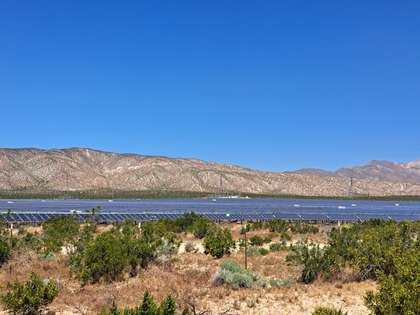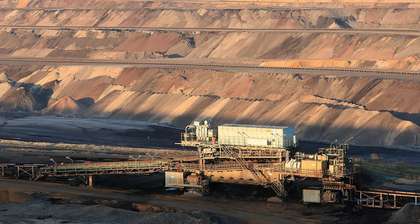Windwitch. What a fitting name - at least from a cyclist’s perspective - for the withered bushes whose thorns unfortunately all too often find their way through our tires. Inconspicuous desert shrubs in their lush state, the dry above-ground part detaches itself from the surviving root section at the end of its life and rolls over stone and path, driven by the hot desert wind. Thousands of seeds in tow, allowing the Russian introduced by ranchers to conquer the American expanse.
From Zion National Park onwards, where we spend the night with Robin in a comfortably equipped Airstream, we find a river again for the first time since the Seine that we can follow for a while. The Virgin River - what a luxury! Plenty of water for bathing and washing, a gentle lapping in our ears at bedtime and our first real cycle path on the American continent.

We see red sandstone cliffs, millennia-old inscriptions (alongside modern scribblings) and a kind of chamois in the Valley of Fire. The originally huge Lake Mead lies retreating from the ‘Northshore’ road in the distance, and then a green wall of palm trees with a blue lake appears like a fatamorgana.
Welcome to Fabulous Las Vegas!
A crazy city in many respects; we are glad to have found a quiet place to stay in the southern suburb of Henderson: Kimberley, James, Elliot, Hannah and Jane give us another lucky break. The whole family is super welcoming and invites us into their home. We have access to a workshop (the newly filed dropouts are still working perfectly, thank you Chuck!), play with the children and are invited to the best fast food in town. Of course, we don’t miss out on a night on the Strip, the famous casino and show mile, while we’re here. In addition to a volcanic eruption, Venice indoors, a giant screen globe and many other unique attractions, we enjoy a really worth seeing dance show. A few days turn into two weeks in the blink of an eye, and a couple of hours jump out for the blog too - among other things, our last trip to the North Cape has now moved here as well.
Once again, we take a slightly different route than planned - towards Death Valley. After an exhausting day with quite a few meters of elevation gain, we are invited off the road for the first time in the United States. Karen (the Bleeding Heart) and Mark welcome us into their garden, including cool drinks, interesting conversations and a hot shower. What a treat!
On the way to the opera in the middle of nowhere, another touring cyclist rides towards us. A quick greeting, happy recognition, the sun is too hot to chat. The descent from the east into the Valley of Death is simply spectacular and is recommended to every cyclist, and speaking of ‘Death’: clever tourist catchers probably gave the region and many terrain formations their figurative names, at the moment the desert here is just about to blossom.
Nevertheless, the environment is challenging for people. Situated almost a hundred meters below sea level, hardly any rainfall - but when it comes, it’s heavy - and today, towards the end of what is still a pleasant time, it’s already blazing hot with 107°F in the shade… for us, the valley is only accessible thanks to a few guaranteed water points provided by the National Park Service.
A well-done exhibition in the Furnace Creek Visitor Center tells of the hardy pioneers who once crossed this landscape, always unsure where the next flowing spring was. Of the local Timbisha, who must have wondered what these crazy people were looking for in the valley again - when everyone knows that water can be found up on the mountain slopes. And of many a short-lived gold rush town - ghost towns and thousands of abandoned mineshafts today - that once promised fabulous wealth.
In the village of Mojave, it’s time for us to say goodbye to the windswept rock formations, washed-out water sculptures and exposed geological curiosities. We can also bid farewell to the sweltering heat, which necessitated good water planning, and unfortunately also to the abundance of sunshine. But it’s not quite that far yet: as we want to speed down from Red Rock Canyon to our sleeping place, gale-force winds make driving difficult. A warning sign drastically points out that motorhomes have already been blown off the road here. The trunks of large juniper trees are clearly moving, power lines are snaking in the wind. Beaufort 7 perhaps? The weather service reports gusts of 40mph - valuable information for us, as this is just about rideable as a crosswind if necessary. Nevertheless, we are glad to find shelter for the night in the shade of the Jawbone Visitor Center.
The desert doesn’t let us simply leave the next day either; we fight our way up to Tehachapi against the wind, surrounded by solar parks and wind farms - the builders obviously knew why they chose this location. The impact on the landscape seems huge, but in terms of area it is on the same scale as the fossil fuel extraction it replaces and remains significantly less drastic.



Through the lovely valley of Oak Creek to the pass of the same name, the surroundings become increasingly green, and on the other side you could almost feel at home. Our Trail Angels Abel and Kim offer us a warm bed and a tasty reminder of Mexico - a real treat after this exhausting and ultimately really cold day. And luckily Abel points out to us that the road through Kern Valley may be closed - in fact it is indeed still shut and we have to divert to Bakersfield in order to reach Sequoia National Park soon.
Looking forward to seeing the red giants!

























































